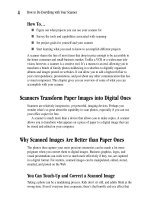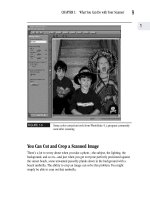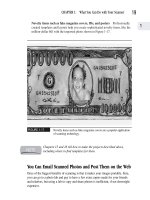How to Do Everything With Your Scanner- P8 docx
Bạn đang xem bản rút gọn của tài liệu. Xem và tải ngay bản đầy đủ của tài liệu tại đây (206.22 KB, 5 trang )
Novelty items such as fake magazine covers, IDs, and posters Professionally
created templates and layouts help you create sophisticated novelty items, like the
million-dollar bill with the imported photo shown in Figure 1-17.
FIGURE 1-17
Novelty items such as fake magazine covers are a popular application
of scanning technology.
Chapters 15 and 16 tell how to make the projects described above,
including where to find templates for them.
You Can Email Scanned Photos and Post Them on the Web
Once of the biggest benefits of scanning is that it makes your images portable. Sure,
you can go to a photo lab and pay to have a few extra copies made for your friends
and relatives, but using a lab to copy and share photos is inefficient, if not downright
expensive.
CHAPTER 1: What You Can Do with Your Scanner
19
1
Please purchase PDF Split-Merge on www.verypdf.com to remove this watermark.
Your new scanner offers you the following options for sharing photos:
You can make your own copies. With a scanner, a decent printer, and some
good-quality paper, you don’t need to resort to a lab to make a simple copy. There
are times when you might want to use a lab to achieve a higher level of quality,
but scanning gives you the option to autonomously reproduce your photos.
You can scan negatives. Some printers afford you the capability to scan
negatives. Chapter 12 tells you more about this optional feature.
You can email a photo. If you know how to email, your scanner gives you the
capability to send your photos electronically. This medium offers the advantages
of instant delivery, and your recipients can print, forward, edit, and delete the
pictures you send to them. Chapter 17 provides you with time- and space-saving
tips for emailing your photos.
You can post photos to a communal website. There are many services on the
Web that allow you to post your scanned photos to a communal website. After you
upload your photos (as explained in Chapter 17), you can give friends and family
a password. This allows them to access and view your photos without having to
download and store them on their own computers.
You can create your own website. Even if you have no prior experience doing
anything like website creation, you too can be the master and designer of your
own website featuring scanned photos you upload. Chapter 17 covers a range of
different products, features, and services that allow you to do this.
Of course, after you get your scanner, you might still want to send pictures via the
U.S. postal service (sometimes referred to as “snail mail”). The next time you do,
however, you have the option of mailing them on a disk or CD!
You Can Organize Images into Easily Accessed Databases
What good is a photo you can’t find? Scanning photos allows you to organize your
memories into digital databases—sometimes called albums. You can give photos and
albums descriptive names, and use search tools within a program to access them
quickly.
Chapter 14 tells you about the features in PhotoSuite 4 and Photoshop
for accessing and archiving photos.
20
How to Do Everything with Your Scanner
Please purchase PDF Split-Merge on www.verypdf.com to remove this watermark.
Other Uses for Your Scanner
Scanning allows you to come as close to editing reality as any technology in history.
It also makes sharing photos with family and friends inexpensive and efficient—but
don’t forget some other important applications for your scanner:
Business applications Scanning makes it easy to share and send promotional
items, and to create impressive logos from digital images to stylize all your
business communications.
Creating trees, charts, diagrams, and other compositions Scanning allows you
to create family trees and organizational charts, combining multiple scanned photos
and sizing them to the exact proportions you need, as shown in Figure 1-18.
FIGURE 1-18
It’s easy to create trees, charts, and diagrams using scanned photos.
CHAPTER 1: What You Can Do with Your Scanner
21
1
Please purchase PDF Split-Merge on www.verypdf.com to remove this watermark.
PowerPoint presentations and slide shows You can use the PhotoSuite digital-
imaging program to create slides from scanned image files, as explained in
Chapter 14. You can also import them, as you would any other image file, into
PowerPoint. If you want to learn more about how to use Power Point to create
presentations from scanned photos, PowerPoint 2000: Get Professional Results
(Osborne/McGraw-Hill, 1999) provides an excellent reference.
A Logical Approach to Getting Started
Scanners are sophisticated technology, but they’re simple to learn. If you’re wondering
the best way to start mastering your new tool, try this approach:
Shop for the right scanner. Identify a scanner model that best meets your
needs, paying close attention to the differing features of various models and which
software comes bundled with them. Chapter 3 provides tips to help you select the
right scanner in your price range.
Become familiar with your scanner and its parts. Try several test scans before
attempting any projects. Chapters 4 and 5 will help you with this phase of the
learning process.
Choose an image-editing program. Decide which image-editing program allows
you to accomplish your planned projects and has an interface you’re comfortable
with. Chapter 9 provides information about different types of image-editing programs
,
their features, and their level of difficulty to master.
Familiarize yourself with image-editing tools. Chapter 10 explains common
image-editing tools, and how to select the right ones for the project tasks you want
to accomplish.
Begin your projects. Experiment with different projects, perusing Chapters 15–17
of this book for ideas.
Within a matter of days, you can expect to become familiar and proficient with
sophisticated image-editing tools that were once the domain of professional
photographers. The learning process begins in Chapter 2!
22
How to Do Everything with Your Scanner
Please purchase PDF Split-Merge on www.verypdf.com to remove this watermark.
How Scanning
Technology Works
Chapter 2
Copyright 2001 by The McGraw-Hill Companies, Inc. Click Here for Terms of Use.
Please purchase PDF Split-Merge on www.verypdf.com to remove this watermark.









